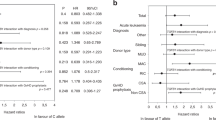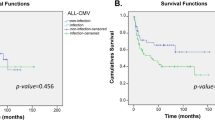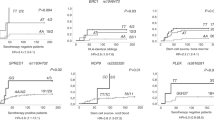Summary:
A total of 110 patients (71 adults and 39 children) who received allogeneic haematopoietic stem cell transplantation from HLA-matched sibling donors were studied for the incidence of acute graft-versus-host disease (aGvHD) in relation to IFN-gamma gene microsatellite polymorphism. A strong tendency was observed towards the lower incidence of grades II–IV aGvHD in patients having an IFN-gamma 2/2 genotype as compared to the recipients with other IFN-gamma genotypes (0.12 vs 0.33, P=0.06). This relationship was independent of the intensity of conditioning regimen and diagnosis. IFN-gamma polymorphic features, together with other clinical and biological factors (patient's age, donor–recipient gender, diagnosis, conditioning regimen, transplant material and GvHD prophylaxis), were subjected to multivariate analysis for aGvHD manifestation in order to exclude indirect association of the IFN-gamma 2/2 genotype. In multivariate analysis, myeloablative therapy (OR=11.462, P=0.013), recipient age (OR=4.896, P=0.009) and lack of IFN-gamma 2/2 genotype (OR=4.311, P=0.048) were found to significantly contribute to the development of grade II–IV aGvHD, while type of GvHD prophylaxis showed less-strong influence (OR=2.963, P=0.066). Thus, it appeared that the IFN-gamma 2/2 genotype constituted an independent and protective factor associated with a decreased risk of grade II–IV aGvHD. However, this genotype was not found to be associated with the risk of cGvHD or survival.
This is a preview of subscription content, access via your institution
Access options
Subscribe to this journal
Receive 12 print issues and online access
$259.00 per year
only $21.58 per issue
Buy this article
- Purchase on Springer Link
- Instant access to full article PDF
Prices may be subject to local taxes which are calculated during checkout

Similar content being viewed by others
References
Holler E . Cytokines, viruses, and graft-versus-host disease. Curr Opin Hematol 2002; 9: 479–484.
Pravica V, Perrey C, Stevens A et al. A single nucleotide polymorphism in the first intron of the human IFN-gamma gene: absolute correlation with a polymorphic CA microsatellite marker of high IFN-gamma production. Hum Immunol 2000; 61: 863–866.
Pravica V, Asderakis A, Perrey C et al. In vitro production of IFN-gamma correlates with CA repeat polymorphism in the human IFN-gamma gene. Eur J Immunogenet 1999; 26: 1–3.
Warle MC, Farhan A, Metselaar HJ et al. Are cytokine gene polymorphisms related to in vitro cytokine production profiles? Liver Transplant 2003; 9: 170–181.
Vandenbroeck K, Goris A . Cytokine gene polymorphisms in multifactorial diseases: gateways to novel targets for immunotherapy? Trends Pharmacol Sci 2003; 24: 284–289.
Socié G, Loiseau P, Tamouza R et al. Both genetic and clinical factors predict the development of graft-versus-host disease after allogeneic hematopoietic stem cell transplantation. Transplantation 2001; 72: 699–706.
Cavet J, Dickinson AM, Norden J et al. Interferon-gamma and interleukin-6 gene polymorphisms associate with graft-versus-host disease in HLA-matched sibling bone marrow transplantation. Blood 2001; 98: 1594–1600.
Lange A, Bogunia-Kubik K, Karabon L, Polak M . An evidence that while differences in polymorphism in TNF-β and IL-6 genes are associated with toxic complications after bone marrow transplantation, differences in IFN-γ gene with a higher risk of GvHD. Blood 2000; 96: 398a (Abstr. 1716).
Przepiorka D, Weisdorf D, Martin P et al. 1994 Consensus Conference on Acute GVHD Grading. Bone Marrow Transplant 1995; 15: 825–828.
Awad M, Pravica V, Perrey C et al. CA repeat allele polymorphism in the first intron of the human interferon-gamma gene is associated with lung allograft fibrosis. Hum Immunol 1999; 60: 343–346.
Lange A, Moniewska A, Fetting R et al. rIL-2-activated killer cell generation is influenced by autologous TNF-alpha production. Nat Immun 1995; 14: 2–10.
Dickinson AM, Sviland L, Dunn J et al. Demonstration of direct involvement of cytokines in graft-versus-host reactions using an in vitro human skin explant model. Bone Marrow Transplant 1991; 7: 209–216.
Bogunia-Kubik K, Wang XN, Fallen P et al. Analysis of effector cells involved in graft versus host disease (GvHD) in bone marrow (BM) graft recipients using an in vitro skin explant model. Bone Marrow Transplant 2002; 29 (Suppl. 2): 168 (Abstr. P639).
Lange A, Klimczak A, Karabon L, Suchnicki K . Cytokines, adhesion molecules (E-selectin and VCAM-1) and graft-versus-host disease. Arch Immunol Ther Exp (Warsz) 1995; 43: 99–105.
Lange A, Karabon L, Klimczak A et al. Serum interferon-gamma and C-reactive protein levels as predictors of acute graft-vs-host disease in allogeneic hematopoietic precursor cell (marrow or peripheral blood progenitor cells) recipients. Transplant Proc 1996; 28: 3522–3525.
Turner DM, Grant SC, Lamb WR et al. A genetic marker of high TNF-alpha production in heart transplant recipients. Transplantation 1995; 60: 1113–1117.
Fishman D, Faulds G, Jeffery R et al. The effect of novel polymorphisms in the interleukin-6 (IL-6) gene on IL-6 transcription and plasma IL-6 levels, and an association with systemic-onset juvenile chronic arthritis. J Clin Invest 1998; 102: 1369–1376.
Lange A, Klimczak A, Wysoczanska B et al. B-cell expansion post transplant is more frequent in patients receiving fludarabine and anti-T-lymphocyte globulin as a part of conditioning regimen and was associated with IFNgamma Intron I polymorphic features. Bone Marrow Transplant 2003; 31 (Suppl. 1): 89 (Abstr. P451).
Wysoczanska B, Bogunia-Kubik K, Suchnicki K et al. Combined association between IFN-gamma 3,3 homozygosity and DRB1*03 in Löfgren's syndrome patients. Immun Lett 2004; 91: 125–129.
Middleton PG, Taylor PR, Jackson G et al. Cytokine gene polymorphisms associating with severe acute graft-versus-host disease in HLA-identical sibling transplants. Blood 1998; 92: 3943–3948.
Karabon L, Lange A . IL-6, IL-10 and IFN-gamma gene polymorphisms acting in concert in patients undergoing HSCT. Genes Immun 2003; 4 (Suppl. 1): 44 (Abstr. 170).
Acknowledgements
This work was supported by a grant from the Polish State Committee for Scientific Research (KBN; No. 6 P05B 056 20).
Author information
Authors and Affiliations
Corresponding author
Rights and permissions
About this article
Cite this article
Mlynarczewska, A., Wysoczanska, B., Karabon, L. et al. Lack of IFN-gamma 2/2 homozygous genotype independently of recipient age and intensity of conditioning regimen influences the risk of aGVHD manifestation after HLA-matched sibling haematopoietic stem cell transplantation. Bone Marrow Transplant 34, 339–344 (2004). https://doi.org/10.1038/sj.bmt.1704581
Received:
Accepted:
Published:
Issue Date:
DOI: https://doi.org/10.1038/sj.bmt.1704581



